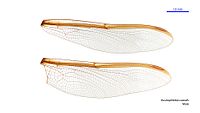Austrophlebia costalis
| Southern giant darner | |
|---|---|

| |
| Male | |
| Scientific classification | |
| Domain: | Eukaryota |
| Kingdom: | Animalia |
| Phylum: | Arthropoda |
| Class: | Insecta |
| Order: | Odonata |
| Infraorder: | Anisoptera |
| Family: | Telephlebiidae |
| Genus: | Austrophlebia |
| Species: | A. costalis
|
| Binomial name | |
| Austrophlebia costalis | |

| |
Austrophlebia costalis, the southern giant darner, is a species of dragonfly in the family Telephlebiidae[3] endemic to eastern Australia.[1]
Austrophlebia costalis is an enormous dark dragonfly with strong yellow markings on its body and a brown band along the leading edge of its wings.[4] It inhabits streams and may be found on logs in shady areas.[5]
This species is believed to be one of the fastest flying odonates, with an old reference claiming to have clocked one at nearly 60 miles per hour (97 km/h) but no modern confirmation.[6]
Gallery[edit]
-
Male from below
-
Male head
-
Female wings
-
Male wings
See also[edit]
References[edit]
Wikimedia Commons has media related to Austrophlebia costalis.
- ^ a b Dow, R.A. (2017). "Austrophlebia costalis". IUCN Red List of Threatened Species. 2017: e.T163523A14258000. doi:10.2305/IUCN.UK.2017-1.RLTS.T163523A14258000.en. Retrieved 19 November 2021.
- ^ Tillyard, R.J. (1907). "New Australian species of the family Aeschnidae". Proceedings of the Linnean Society of New South Wales. 31: 722–730 [724] – via Biodiversity Heritage Library.
- ^ "Species Austrophlebia costalis (Tillyard, 1907)". Australian Faunal Directory. Australian Biological Resources Study. 2012. Retrieved 8 March 2017.
- ^ Watson, J.A.L.; Theischinger, G.; Abbey, H.M. (1991). The Australian Dragonflies: A Guide to the Identification, Distributions and Habitats of Australian Odonata. Melbourne: CSIRO. ISBN 0643051368.
- ^ Theischinger, Günther; Hawking, John (2006). The Complete Field Guide to Dragonflies of Australia. Collingwood, Victoria, Australia: CSIRO Publishing. p. 136. ISBN 978-0-64309-073-6.
- ^ Tillyard, Robert John (1917). The Biology of Dragonflies (PDF). pp. 322–323. Archived from the original (PDF) on 3 July 2017. Retrieved 15 December 2010.
I doubt if any greater speed than this occurs amongst Odonata





